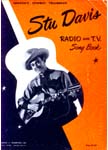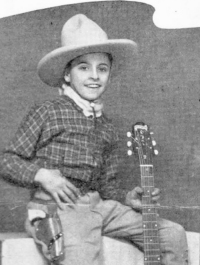



|
 |
|||||||||
|
About The Artist We first learned about Olivio Santoro when we came across a booklet attributed to Olivio called "How To Yodel". Now, how much weight you're going to give such a booklet when the cover picture is of a young lad who looks to be ten or 12 years old or some very young age and whether he's really able to tell you how to yodel would be an interesting conversation. But we'll take it in the context of the youngster trying to tell his radio fans how he goes about it and the twists he puts into it. The booklet is very small - maybe the size of a 4 x 6 photo and only eight pages. At the time it was published, he was on radio station WJZ at 5:15pm Sundays on the NBC Blue Network. This places it around the early 1940s based on some radio program schedules we've seen in the New York Times newspaper archives. Let's read a bit of the intro to get an idea of how he tried to simplify the art of yodeling. "Folks, yodelling is fun! Long before people knew any words, they expressed their happiness by yodelling. When you're happy, yodel! When you're sad, yodel and get happy! Come on, everybody...yodel along with me!" In a bit of a humorous note, the New York Times reported in 1941 that Olivio had gone six months without breaking a guitar string. They reported that because the last time it happened on the air, it sounded like a gun shot being fired and caused some concern by the listening audience. Eugene Burr wrote a review of Olivio's show in the September 26, 1942 issue of Billboard magazine. At the time, the show was aired on Sundays from 11:45 to 12 noon over WEAF, on the NBC Network and sponsored by F. G. Vogt and Sons. At the time, Olivio was 14, but the reviewer seemed to be of the opinion that there were too many child acts on the air and thought the wonder was that they were even on the air at all. By that time, Olivio had been on the air some six years on a show called the "Children's Hour" and was now doing his own show over NBC, airing over ten stations for at least two years. The author tried to not get too hung up on the sponsor of the show - Thrivo Mix, a dog food. Now we get to Mr. Burr's review. "Olivio's voice is fair enough, tho his Western twang is sometimes painfully synthetic, and his tendency to reach for folk flavor by putting a whine into his voice is so strong that he could frequently double as a train whistle. He is a terrific guitarist—but even here he ruins his effect by a wrteched selection of songs. All are synthetic—not a real folk tune in a noseful." He had two other singers on this show and well, Mr. Burr comes off sounding like the Simon Cowell of his day when he speaks of them. There was a four year old singer by the name of Bobby Hookey, who he described as cute, but "exceptionally hard to take". Then there was a twelve year old female singer that was being promoted as the Little Betsy Ross, Marian Loveridge, who was known for the patriotic type of songs she would do. When she sang "When You're A Long, Long Way From Home", Mr. Burr said she sang it with "schmaltz". "So fiendishly schmaltzy is little Miss Loveridge, in fact, that she makes Kate Smith sound like an iceberg." His last barb or parting shot in his review..."If they really sang folk tunes, the program might not be so bad." Sounds to us that he was afraid to admit he liked that type of music and had to keep up a snobby east coast urban air? But then, you have to appreciate reading that type of review compared to what we see today. They weren't just reprinting the hype from a public relations firm. According to one of the internet sites devoted to Old Time Radio, Olivio had the number 8 rated daytime radio program on Saturdays and Sundays in 1941 and 1942 in the New York City area, sponsored by Vogt Scrapple. The show aired over the NBC Blue network at 5:15pm on Sundays then. In 1950, he was being seen and heard over WNBT-TV in the New York area on a show called "Friendship Ranch" on Channel 4 along with Cricket Skilling. Credits & Sources
|
| Printer Friendly Version |
Hillbilly-Music.com
Yes, Hillbilly Music. You may perhaps wonder why. You may even snicker. But trust us, soon your feet will start tappin' and before you know it, you'll be comin' back for more...Hillbilly Music.
Hillbilly-music.com ...
It's about the people, the music, the history.
|
Copyright © 2000—2023 Hillbilly-Music.com
|
||||